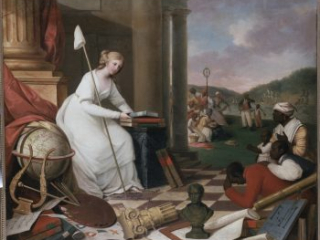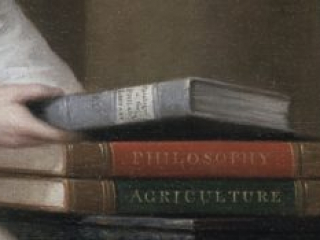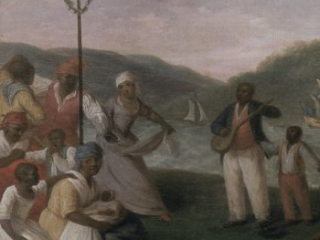Is Samuel Jennings Painting at the Metropolitan Museum of Art
In 1792, Samuel Jennings, a native of Philadelphia living in England, painted an allegory symbolizing the abolition of slavery for the reading room of the Library Company of Philadelphia, the oldest private library in the Us and a middle of antislavery idea and activeness. This lesson challenges students to interpret the rich symbolism in the painting to reveal what the painting meant to the directors of the Library Visitor who instructed Jennings, and more broadly about how they imagined slavery should be ended.
Suggested Form Level
Middle and High School
Recommended Fourth dimension Frame
One +/- fifty-infinitesimal session
Objectives and Essential Questions
Students volition:
- connect the antislavery movement of the Revolutionary generation to the principles of freedom and natural rights;
- learn how the religious principles of Pennsylvania Quakers shaped abolition in Pennsylvania and helped make Philadelphia a center of antislavery idea and action;
- and
- develop skill to translate emblematic images used past early American artists to deliver political messages.
Materials and Resources

Liberty Presenting the Arts and Sciences (1792) past Samuel Jennings is one of first works of fine art by an American to express antislavery ideas (Library Company of Philadelphia).
- Liberty Displaying the Arts and Sciences , or The Genius of America Encouraging the Emancipation of the Blacks, Samuel Jennings, ca. 1792, Library Visitor of Philadelphia.
- Written report For Freedom Displaying the Arts and Sciences, or The Genius of America Encouraging the Emancipation of the Blacks, Samuel Jennings, ca. 1791–92, artist's sketch Metropolitan Museum of Fine art, New York.
- Liberty Displaying the Arts and Sciences, Samuel Jennings, ca. 1792, re-create for engraving, Winterthur Museum, Garden and Library.
- 4 details from Freedom Displaying the Arts and Sciences , or The Genius of America Encouraging the Emancipation of the Blacks, Samuel Jennings, ca. 1792, Library Visitor of Philadelphia.
Background Knowledge
The American Revolutionaries appealed to ethics of liberty, equality, and natural and civil rights to explain the aims of their revolution confronting British rule.
On January 12, 1790, Samuel Jennings, who was living in London, wrote to his father in Philadelphia to say that he had learned that the Library Company of Philadelphia would shortly motility to a new building. The Library Company, which had been founded by Benjamin Franklin in 1731 was 1 of the most important libraries in America. Jennings asked his father to approach the directors of the library with his offering to paint a picture for the new library edifice. He suggested a painting of Minerva, the Roman goddess of wisdom, who was also a patron of the arts and of merchandise, but said he would exist honored to paint anything the directors wanted.
On Apr 3, 1790, the directors wrote to Jennings accepting his offer. They described the scene they wanted Jennings to paint:
the effigy of Liberty (with her cap and proper Insignia) displaying the arts past some of the most striking symbols of Painting, Compages, Mechanics, Astronomy, etc., whilst She appears in the attitude of placing on the top of a Pedestal, a pile of Books, lettered with, Agriculture, Commerce, Philosophy, & Catalogue of Philadelphia Library. A Broken Chain at her feet, and in the distant back Ground of a Groupe of Negroes sitting on the Earth, or in some mental attitude of expressive of Ease & Joy.
The painting Samuel Jennings made for the Library Company of Philadelphia invoked the Revolutionary ideals of liberty and natural rights to accelerate an abolitionist message.
The directors of the Library Visitor who wrote to Jennings were in favor of the abolition of slavery. Philadelphia had i of the largest and nigh song group of antislavery advocates in the land. The city had been founded by Quakers, amid whom were some of the commencement and most active opponents of slavery in the colonies. By the Revolution Philadelphia was the largest and most cosmopolitan city in British America, widely admired for its dedication to rational improvements—clean, well-lit streets, a hospital, a library, admission to clean water, fire companies—and its commitment to the interests of ordinary people. The antislavery movement attracted non-Quakers, and together they formed the Guild for the Relief of Free Negroes Unlawfully Held in Chains in 1775. The group was reorganized in 1784 as the Pennsylvania Club for Promoting the Abolitionism of Slavery and for the Relief of Free Negroes Unlawfully Held in Bondage.
Members of the grouping agitated for the Pennsylvania Act for the Gradual Abolition of Slavery, which was adopted by the General Assembly in 1780. Despite this victory, the abolitionists nonetheless had piece of work to do. They believed Americans had escaped the tyranny of the British monarchy and that Americans must extend the blessings of liberty to people held in slavery. The directors of the Library Company asked Jennings to paint a scene reflecting this ideal. Jennings agreed and completed the painting in London in 1792 and shipped it to Philadelphia, where it was displayed in the Library Visitor's building.
Sequence and Procedure
-
-
- Start innovate the terminal version of the painting owned by the Library Company of Philadelphia. Explicate the title and the concept of allegory, an image that uses symbols to convey a moral or political pregnant. The revolutionary generation oft used symbols from classical antiquity (aboriginal Greece and Rome), historical examples of a democracy and a republic that inspired revolutionaries and artists alike.
- Point out some of the symbols in the paintings and ask students to identify as many as possible and brainstorm what revolutionary values they might represent. Here is a listing of the symbols and their basic meanings, although students may have dissimilar interpretations:
-
-
-
-
- Freedom herself, representing the promise of the Revolution. During the Revolution, freedom was depicted in diverse ways. The liberty tree and liberty a pole were among the well-nigh mutual. Liberty could also be depicted as a classical goddess, and during the Revolution and in the years afterward, Liberty was most frequently depicted in this way. The white robes she wears represent the purity of the blessings she bestows on humanity. Instead of a toga-like garment worn by classical goddesses, Jennings version of Freedom wears more contemporary clothing.
- Cleaved chains under her feet advise the emancipation of the slaves, the liberating power of knowledge, and the intention of the Revolutionary project to end tyranny and bondage.
- Liberty bears a vindicta, a long rod used in the ancient Roman manumission ceremony topped with the pileus, the white cap of a free human being. Freed slaves would be touched with the rod and put on the cap when they were released from chains.
- The goddess is holding the Library Company of Philadelphia'southward itemize, symbolizing knowledge. The Library Company was one of the greatest repositories of cognition in the The states. Members pooled their resources to purchase books, which were more expensive to make and buy than they are today.
- The black people in the painting wear Western apparel and are represented as free people rather than every bit servants or slaves. This is highly unusual in Western art of the eighteenth century. 1 of the primary goals of the abolitionists during this era was the education of freed blacks, and the painting shows them gratefully receiving knowledge from the goddess. Inquire the students to come up with adjectives to draw the black characters in the painting to tease out what abolitionists believed their efforts would achieve.
- The two books resting beneath the plinth adjacent to Freedom are labelled Philosophy and Agriculture, two subjects that were important to the success of the newly independent states and important to the directors of the Library Company. Philadelphia was the dwelling of the American Philosophical Society and Philadelphia Lodge for Promoting Agriculture.
- Volumes of Homer and Virgil, the two masters of classical poesy, lean against the column where Philosophy and Agriculture are placed.
- Modern English literature is represented, in the lower left corner with volumes of John Milton, William Shakespeare, and the Scottish poet James Thomson.
- Scientific discipline is also represented by sheets of calculations in the lower right with geometry calculations and a diagram titled "mechanics."
- The globe represents geography.
- The lyre represents music, it is set on tiptop of a scroll with notes from "Come, ever-Smiling Liberty" from Handel'due south oratorio Judas Maccabeus.
- The telescope represents astronomy.
- Palette and brushes correspond painting and the visual arts.
- The bronze bust of the man in the foreground is probably of a British abolitionist, either William Wilberforce, abolition's well-nigh ardent champion in British parliament, or Henry Thornton, the chairman of the Sierra Leone Visitor, which sought to return freedmen to Africa.
- Commerce is represented by ships in the background, since seafaring was key to business and prosperity in the Revolutionary era.
-
-
- After interpreting the symbols as a class, accept the students to write down what they call back the primary idea or message of the painting is and and then ask them to share it with the class.
- Inquire students to split into small groups to identify the differences between the three versions of the painting, keeping in listen that the creative person'south sketch held at the Metropolitan Museum was made for an American audience and the version at the Winterthur Museum was intended for a British audience. Jennings created the copy at the Winterthur Museum because he wanted to sell engravings of the image to British abolitionists. Ask the students what these subtle differences suggest about the purpose of the portrait in the transatlantic antislavery movement.
Questions to consider as a class:
- Achieving liberty was a fundamental goal of the American Revolution. How would yous define Liberty? What does this painting tell us about how the early antislavery move thought about Liberty? Take each pupil consider this question by themselves for two minutes before discussing it with a partner.
- What does this painting reveal nearly the intentions of the Library Company of Philadelphia and the Revolutionary ideals that informed its mission?
- Why do you lot call back the Library Company wanted to acquire an allegorical painting like this?
- What does the depiction of African Americans in this painting tell united states of america about how early abolitionists thought the abolition of slavery would alter the lives of people who had been enslaved? How did they believe this modify could be accomplished?
- In February 1790, within days of the directors of the Library Visitor receiving Samuel Jenning'south offer, Benjamin Franklin petitioned Congress on behalf of the Pennsylvania Social club for Promoting the Abolitionism of Slavery. As a class, compare the main ideas of the petition with the principal idea of Jenning's painting. What does Franklin's statement reveal most the intentions and motivations of the Pennsylvania Abolition Guild and the message the Library wanted to ship in the painting in 1792?
Philadelphia February 3, 1790
Respectfully Sheweth,
That from a regard for the happiness of Flesh an Association was formed several years since in this Country by a number of her Citizens of various religious denominations for promoting the Abolition of Slavery & for the relief of those unlawfully held in bondage. A simply & authentic Conception of the true Principles of liberty, as it spread through the land, produced accessions to their numbers, many friends to their Cause, & a legislative Co-performance with their views, which, by the blessing of Divine Providence, have been successfully directed to the relieving from bondage a large number of their fellow Creatures of the African Race. They have also the Satisfaction to observe, that in consequence of that Spirit of Philanthropy & 18-carat liberty which is generally diffusing its beneficial Influence, similar Institutions are gradually forming at domicile & abroad.
That mankind are all formed past the aforementioned Almighty being, alike objects of his Care & equally designed for the Enjoyment of Happiness the Christian Religion teaches united states of america to believe & the Political Creed of America fully coincides with the Position. Your Memorialists, particularly engaged in attending to the Distresses arising from Slavery, believe it their indispensable Duty to present this Subject to your notice. They have observed with corking Satisfaction that many important & salutary Powers are vested in you lot for "promoting the Welfare & Securing the blessings of liberty to the "People of the United states." And every bit they conceive, that these blessings ought rightfully to be administered, without distinction of Colour, to all descriptions of People, so they indulge themselves in the pleasing expectation, that nothing, which can be done for the relive of the unhappy objects of their care, volition be either omitted or delayed.
From a persuasion that equal liberty was originally the Portion, Information technology is even so the Birthright of all men, & influenced by the strong ties of Humanity & the Principles of their Institution, your Memorialists conceive themselves jump to utilize all justifiable endeavours to loosen the premises of Slavery and promote a general Enjoyment of the blessings of Freedom. Under these Impressions they earnestly entreat your serious attention to the Subject of Slavery, that you will be pleased to countenance the Restoration of liberty to those unhappy Men, who alone, in this state of Freedom, are degraded into perpetual Bondage, and who, amid the general Joy of surrounding Freemen, are groaning in Servile Subjection, that yous will devise means for removing this Inconsistency from the Character of the American People, that y'all volition promote mercy and Justice towards this distressed Race, & that you will Pace to the very verge of the Powers vested in y'all for discouraging every Species of Traffick in the Persons of our swain men
Franklin
President of the Society
Assessment and Demonstration of Student Learning
Have the students write 1 or 2 paragraphs about one of the symbols in the prototype and why this concept was key to the germination of the ideals of the American Revolution and the early on abolitionist movement.
Extension
Robert Edge Pine, a British painter who was sympathetic to the American cause, painted a large emblematic sheet in 1778 he titled America, which he described as an emblematic scene in which "America, later on having suffered the several evils of war, bewailed its unhappy crusade, and lamented over the victims of its fury—her ruined towns—destroy'd commerce, &c. &c. On the advent of Peace, is represented an extacy of gratitude to the Omnipotent—Heroic Virtue presents Freedom attended past Concord—Manufacture, followed by Enough and her Train, grade a group expressive of Population; and Ships announce Commerce." Suffering America weeps at a cenotaph to four American heroes of the war—James Warren, James Montgomery, David Wooster and James Mercer—who had fallen in battle.
Pino employed Joseph Strutt to engrave a plate of America, which Pine published himself. The impress is defended "To Those who wish to Sheathe the Desolating Sword of War And to Restore the Blessings of Peace and Amity to a divided People." Pine emigrated to America in 1784 and supported himself painting portraits, which occupied most his time until his death in 1788. Pino exhibited America in Philadelphia and sold copies of the print. The original painting was destroyed in an adventitious burn in 1803 (for more on the impress, see Ten Great Revolutionary State of war Prints).
Members of the Pennsylvania Abolition Order might have had this painting in mind when formulating a asking for their own emblematic painting promoting emancipation. The members of the Order may have been familiar with the painting.
Questions to consider every bit a class:
- In the print of America, dissimilarity what is happening on the left side of the scene with what is happening on the right.
- Based on Robert Edge Pine's clarification of the scene, what does the flying female effigy represent?
- How does the symbolism of this image made during the Revolutionary War compare to the symbolism of Liberty Displaying the Arts and Sciences?
- What is the bulletin of each allegory and how are they related?
Revolutionary Achievements Category
Highest Ideals
Exploring the Revolution Category
Revolutionary Democracy
Consider the related lesson A Plea to Cease Slavery: The Essay of "Phonation Africanorum" in the lesson plan collection Revolution on Paper.

Click here for larger view
Liberty Displaying the Arts and Sciences, or The Genius of America Encouraging the Emancipation of the Blacks
Samuel Jennings
1792
Library Company of Philadelphia
Artists preparing to paint a large work like Freedom Presenting the Arts and Sciences often painted a much smaller oil sketch like this one. Other than the fact that the sketch is not as finely detailed every bit the concluding work, what are the differences between the two? Can yous discover iii differences the sketch and the concluding work? Why practise y'all recall the creative person altered his programme and fabricated those changes? 
Click here for larger view
Freedom Displaying the Arts and Sciences
Samuel Jennings
ca. 1791-1792
artist'south sketch
Metropolitan Museum of Art
The creative person painted this copy to serve every bit the footing for an engraved print of the painting he hoped to sell. He added i important detail to the painting, which is not institute in his oil sketch or the finished painting he sent to the Library Visitor of Philadelphia. What is that new detail? Tin you find it? What does it tell us about who he intended to sell the impress to? Why did the artist think they would exist interested in buying a print of this painting? 
Click here for larger view
Liberty Displaying the Arts and Sciences
Samuel Jennings
ca. 1792
re-create for engraving
Winterthur Museum, Garden and Library
In this detail from Freedom Presenting the Arts and Sciences, Liberty is placing 3 books, titled Philosophy, Agronomics, and Catalogue of the Philadelphia Library on a column.Why did the artist depict her placing these book there? Are the study of philosophy and agriculture related to the abolition of slavery? If so, how? 
Click here for larger view
Liberty Displaying the Arts and Sciences
Samuel Jennings
1792
detail of books
Library Company of Philadelphia
In this item from Liberty Presenting the Arts and Sciences, the artist has included a page from George Friedrich Handel's oratorio Judas Maccabeus, which follows the Erstwhile Testament story of an ancient Hebrew revolt against tyrants intent on enslaving them, a copy of John Milton's works, which include Milton's idea that religious, personal, and ceremonious liberty is essential to civilized life, and at the lesser of the stack, a copy of the Scottish poet James Thomson's Seasons, a work completed in 1730 and known for its condemnation of the slave trade. What message was the artist trying to convey by including these works in the painting? 
Click here for larger view
Freedom Displaying the Arts and Sciences
Samuel Jennings
1792
detail of books and music
Library Company of Philadelphia
In the groundwork of Liberty Presenting the Arts and Sciences, a blithesome group of African Americans dance. What are they dancing around? Other than dancing, what most the group indicates that they savour the benefits of liberty? 
Click here for larger view
Freedom Displaying the Arts and Sciences
Samuel Jennings
1792
detail of figures in background
Library Visitor of Philadelphia
What well-nigh these people portrayed in Liberty Presenting the Arts and Sciences indicates that they are gratis? 
Click hither for larger view
Freedom Displaying the Arts and Sciences
Samuel Jennings
1792
detail of figures in right foreground
Library Company of Philadelphia

Click here for larger view
America To those, who wish to sheathe the desolating sword of war
Robert Edge Pine
1781
The American Revolution Plant of the Society of the Cincinnati
sleathfackeffaced.blogspot.com
Source: https://www.americanrevolutioninstitute.org/lesson-plans/imagining-the-revolution/imagining-the-abolition-of-slavery/